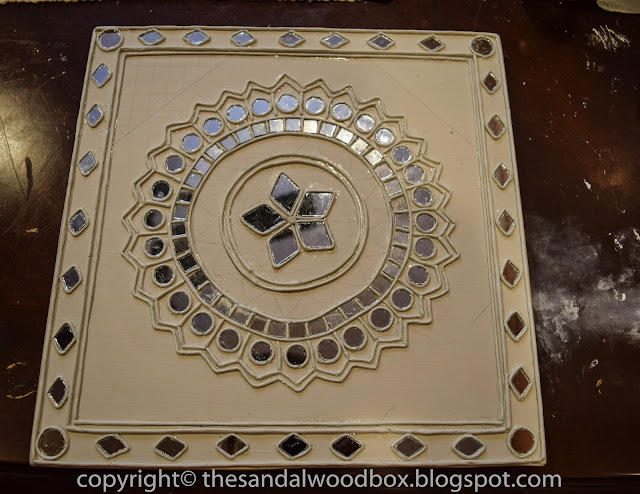Lippan
kaam or Lippan work is a traditional art form from Western India and is mainly done by women
of the Rabari community of Kutch, Gujrat. This mud relief work is done on the
inside mud walls of bhungas (mud huts) using dung or clay. The word ‘Lippan’
translates to clay or dung and ‘kaam’ to work.
The
mixture of camel dung and hay is molded between fingers and stuck directly on
walls. Geometric patterns and traditional Kutch motifs are sculpted freehand.
Each pattern in embellished with small mirrors of various sizes and shapes. In addition to geometric patterns and Kutch motifs, it is common to see birds, trees, animals, and human figures in Lippan kaam.
The
mud mixture is prepared by kneading clay or camel dung with hay (as it contains
fibers serving as a binding agent) with water. Glue or starch is used to stick
small mirrors or dried seeds of different sizes and shapes.
Though
the authenticity of Lippan kaam lies in a completed piece that is all white or
in shades of neutrals; bright colors like red and green are sometimes painted
on the dried clay work.
Mostly
done by women, this is usually done in groups while chatting or singing
bringing a sense of togetherness. These scintillating murals bring life, gaiety,
and beauty to their generally harsh life. The women are so experienced in this
art form that they usually don’t draw or trace a pattern before beginning work.
It is inherent nature within us to want to decorate our homes and
surround ourselves with beauty, beauty as each one of us sees it.
Here's my Lippan work....!!
I
has originally envisioned a large 4 feet by 4 feet Lippan wall art for my
fireplace brick wall; but I figured I should first familiarize myself with the
workings before I jumped into my grand vision. So I decided a smaller piece
would add nicely to my mirror wall. I chose a small 12 by 12 piece of wood leftover from another project.
After sanding and smoothing the edges, I painted the surface using
acrylic paint in a neutral color ‘tapioca’ (I felt white might be too stark). I
measured and drew out a rough pattern to give me an idea of placement and
spacing. I set out all the mirrors in different shapes and sizes, E6000 glue, toothpicks, paper towels, and my mug of tea and I was ready to go.
I mentally divided the design in sections—the frame layer, the layers
on the inner circle pattern, and the final fillers. I chose air drying clay as
my medium. Air drying clay dries very fast and so it is important to work in
small sections pulling out only a little clay at a time. Keep the rest of the
clay covered in a wet paper towel inside a ziploc bag. Working in each layer,
you glue the mirrors first. Then roll out a bit of clay into thin rope like
sections. Put a little bit of glue around each mirror and lay the rolled out
clay around the mirrors. I used a toothpick to guide the rolled out clay into
place so as to not make indentations or finger prints. If the clay dries a bit,
it is difficult to lay out smoothly without cracks or breaking, so make sure
you work with a little at a time and you keep the rest covered under a wet
paper towel.
Just
keep going…you get the hang of it pretty quick. J
Once done erase all the pencil marks, scrape the dried up glue as best as possible, and clean the mirrors. I also touched up a little of the background paint...it just brightened it all up and also helped cover up the pencil markings too.
Doesn’t
it look nice? What do you think? the imperfections in the mirrors and the clay itself lends an earthiness to the entire piece.
Be
sure to visit these sites to check out some cool pics and instructions:














